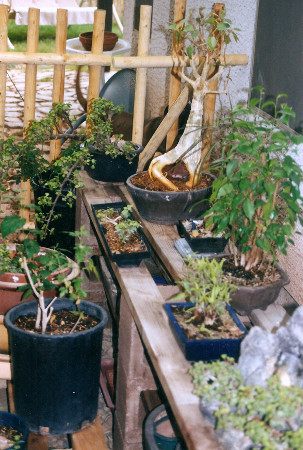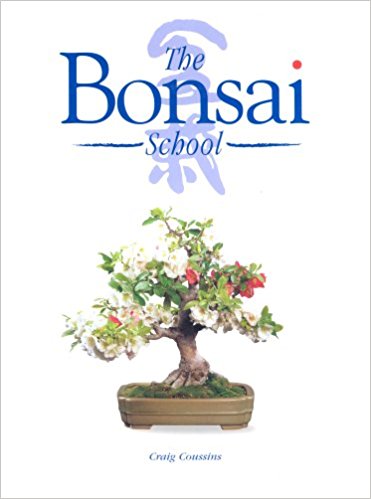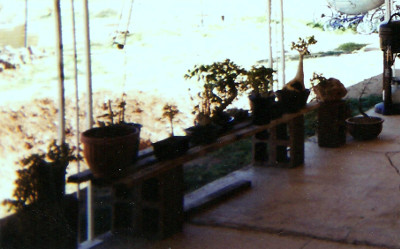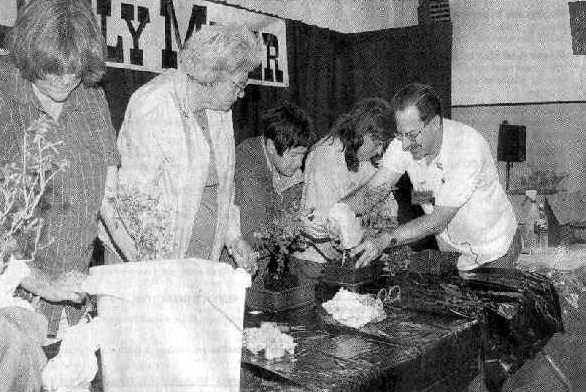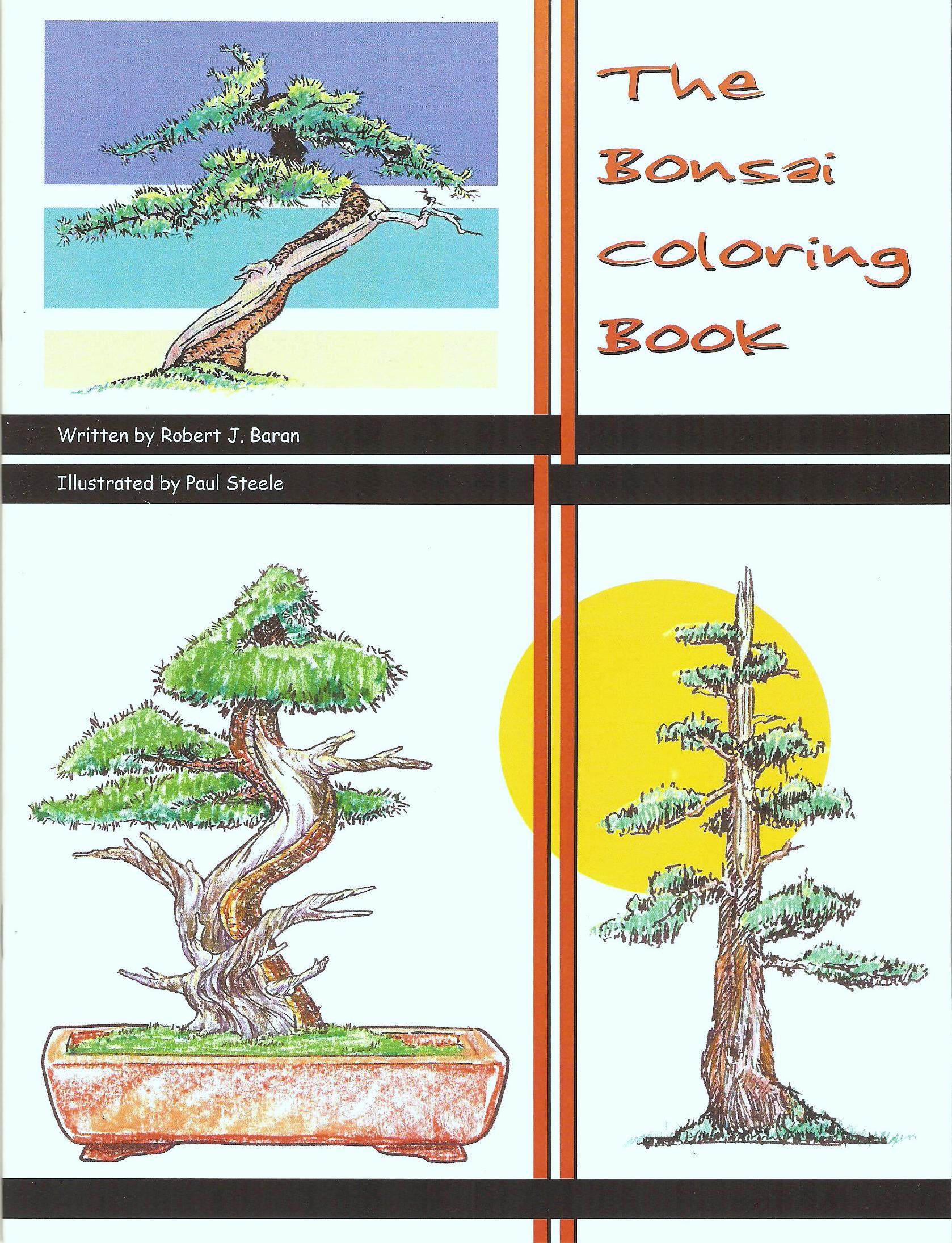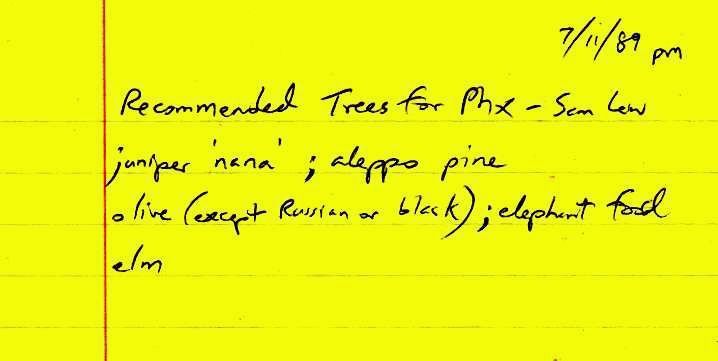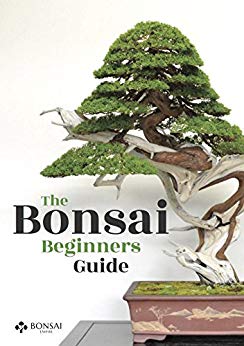My earlier collecting of postage stamps begun in the mid-1960s -- especially
of space-related images -- also had several from China which included a few with bonsai/penjing. Some of the
postage stamps'
image scans used on this website (from October 1999 on) were also e-mailed to me because of the others seen on
the site (early archive copy linked here). A listing of specifically
fraudulent stamps
was started in May 2005 (early archive copy linked here). (I am aware of the arguments about not depicting
such issues. However, the graphics I have for these are definitely not mint-quality for further illegal
replication, and the authority source text is not detailed enough for complete identification. This is
an educational website.)
By the end of 2003 we had the first
Magazine Covers,
and the first historical
Anomalies
(early archive copies linked here).
In late October 2004 I started searching the Library of Congress online links
to the Memory of America project for
optically scanned issues of periodicals from the 19th century. Several early article references to dwarf
trees were discovered there and typed/proofed on to this site.
A number of times a year or so I'll spend a few hours looking on the
Internet for useful additional background for any of the material already here on this site. That's
basically where updates come from. BTW, I have mixed feelings when I enter a search phrase/person's
name and our site comes up as the only result. Yes, I am glad that this website is so authoritative
on the subject; but, no, when I am searching I want some new information!
Growing up I did read a few history and archaeology texts -- most memorable was C.W. Ceram's
Gods, Graves and Scholars.
Archaeology was considered one of my career paths in grade school. (Life happened and I chose marine biology
in high school, which became Radio-TV-Film due to college choice based on family budget during
the recession, which was then interrupted
by the real world after three years.) My childhood home, because of my parents, received National
Geographic and Life magazines, as well as Look, Popular Mechanics, and Popular
Science. I later became a fan of Smithsonian magazine and Science News. Early on I
had become the family historian, both as genealogist and keeper of some old headline newspapers and magazines.
(A four-page typewritten manuscript compiled sometime in 1971 by a distant cousin told the story of my maternal
grandmother's mother's family in Austria-Hungary dating back to the eleventh century. When I was given a
copy of this, I traced the family's household moves and matched some of them up with historical Turkish invasions,
for instance. Most of the references to the Turdossy family line on the Internet, by the way, apparently
originated from other people's copies of that four-page document.)
My note-taking and article-clipping days go back to grade school, memorably
including David Dietz's syndicated newspaper science
column. Numerous newspaper and magazine articles became dust in an un-cooled closed-down office in Phoenix
during a summer c.1976. I started clipping again with a passion and a decade later I had a private
classification system for a couple hundred folders' worth of material.
My interest in Japan dates back to grade school when my uncle -- the same
one as mentioned above -- sent home a few [non-bonsai] items from Japan during his short military posting
there. (I found the Reader's Digest Murata article a couple years
later.) My interest in things Chinese probably dates from a decade further on. Over the years various
projects I've worked on have made me aware of some of the promise and perils of research and translation,
including some extensive genealogical historical studies. In the past three decades or so I've read
occasional in-print or electronic articles regarding writing and researching history to specifically help me stay
focused. I had no formal history training after the standard classes in college. Also, I devour works
on legitimate historical revision, history trivia, debunking of pseudohistory, and archaeological discoveries
around the world -- officially recognized or not. There has also been exposure over time to various broadcast
or recorded programs from the Public Broadcasting System, the History Channel, A&E, the Discovery Channel,
and so forth. Plus, it is not so much academic knowledge as just understanding what it is that I have been
doing for thirty-seven years in compiling this history. The hundreds of articles and hundreds of books I've
looked at do have their own patterns and flows, sometimes immediately evident, sometimes made aware of during
meditation upon a different book. I take a variety of notes and make some photocopies in addition to my
high memory-retrieval rate.
My horticultural interest started also during grade school when I helped
my dad with his vegetable garden at our house in the Cleveland suburb of Seven
Hills. (My mom's father also had a vegetable garden, but he passed away when I was six years old so my
memories of him were brief.) Dad's garden of a few hundred square feet (as best as I can remember) extended
slightly off the property into an undeveloped section of woods, and when I discovered bonsai at the end of the
decade, my first field-collected specimens were a couple of about foot-tall red maple saplings from those
woods. A young beech growing alongside a much larger and mature "Gray root" specimen never got to be
collected by me -- probably for the better.
The woods were over hundred acres, I guess, just south of Rockside Rd., with
oak and maple trees, in particular. One section was actually an overgrown portion of pioneer property with
the remnants of a split-rail fence now deep in the woods. Large dark weather-varnished sandstone slabs dotted
the ground in a few places, amid the ferns, vines, goldenrod, Queen's Anne lace, a few wild strawberries and dwarf
roses, and many other types of plants I remember. Robins, cardinals, blue jays, wrens, and crows flew above,
along with bumblebees, honey bees, lightning bugs, swallowtail butterflies, and mosquitos; salamanders, frogs,
garter snakes, chipmonks and squirrels scampered below, along with isopods, earthworms, big black crickets, and
daddy longlegs. A continuously running storm sewer emptied out into stones, sand and old concrete segments
to be filtered and end up a quarter mile away in a small pond with cattails, raspberries, frogs eggs, and a small
patch of clay. Many hours and week-ends were spent in the woods during those "innocent" days of the suburban
1960s, either by myself or accompanied by the family dog. (I understand that some of the woods were torn down
when the previously incomplete street -- cleared earlier but unpaved and thus known by us as "the Path" -- to the
north of our old house was eventually developed. Of course, it has been over fifty years since we moved
from the Cleveland area. I was back only twice during that time, and neither visit allowed me to see the old
neighborhood. I've since viewed it on occasion via GoogleMaps -- and as the saying goes, "you can't go home
again" to the way it used to be...)
My gardening with dad continued with our family's move to Phoenix, and years
later I had my son Andrew and niece Patricia (b. 1984 to my older brother Michael) help me with some spring planting
in dad's garden. (When I set up a Facebook account in 2008 and friended Patricia, she would remind me of her
pleasant memories of that.) Andrew grew up with my mostly apartment balcony bonsai collections, and he helped
a few times here after we were settled in Colorado with my own vegetable garden (now up to over 1,500 square
feet/140 sq meters -- larger than the floorplan of our small rental house). In 2016 my son grew some veggies
on his own apartment balcony, and he did a slightly larger -- but less successful -- spread the following year.
A new round two years ago included an attempt with a blueberry bush, as he was also doing last year with
indoor-started seeds again. Meanwhile my son Kenny (b. 1989), daughter Raechel (b. 1996), and their niece,
granddaughter Alice (b. 2014) have helped me in my garden at various times over the past few years, laying down
memories in their own ways.
The written sources I do check out are basically approached two ways: either a
book or article is known or suspected to have some of this history in it or else the material is believed at
least to have useful general background info. Either of these two sources might contain illustrations
of bonsai portrayals. I have looked at scores of art and landscape books while searching for previously
unseen pictures -- again, primarily about Chinese or Japanese collections or subjects. Titles or persons
mentioned in any of the above are then looked up on the Internet for additional details. If additional
details are to be found or seem to be found in new books or articles, these are then researched similarly.
And the hunt can begin again. Many times I have had one or two more titles to be ordered through the
InterLibrary Loan system...) Plus, the Internet can be a wonderful source of material on innumerable
subjects -- judiciously considered, especially in light of my past researches and readings. Facebook has
provided me with a few additional portrayals, but usually without any significant background data.
Regarding
A Suggested
Timeline for the Development of Magical Miniature Landscapes (early archive copy linked here),
"Last November [2004] I started building this particular web page based on
key notes from my unpublished manuscript/researches. I decided I needed to then have the footnotes available
in order to continue the unwritten theme I've used in creating this website: a well-documented and detailed
exploration. (In the 1960s and 70s issues of the bonsai magazines, there were so many short articles/space
fillers rehashing just a few points of the history. Shortly after I started my researches I learned that
I had come upon info not previously published in these articles or books, so I continued...) I initially
realized that many of the chronology notes were from sections [of my manuscript] whose citations had been grouped
by chapter, essentially blending the origin of the specific points. So, I started to comb through all my
old notes, earlier drafts and assorted photocopies of source material gathered since early 1986. Only the
other day I decided that the motivation to complete this was by putting what I had right now on the web. So
I did a 'final push' yesterday and published what I had.
"I know additional points will further flesh out this chronology which is, I
suppose to be technical, my working hypothesis on how magical miniature landscapes developed out of the various
suggested cultural sources to be what it is today."
from RJB's e-mail to Marty Haber, May 23, 2005, after Marty complimented the
page. The three column format mirrored a tri-fold heavy cardboard poster (each section 28"W x 44"H or 71.1cm
W x 111.8cm H), similarly headed, which I used for my second talk before the Phoenix club. (That poster for many
years was sitting less than 2 feet/61 cm away from me as I typed this...)
[The second significant and major corporate history I worked on was for
a county-owned regional medical center where
I worked from June 2002 through June 2005. I'm sure I used some of the skills developed for this bonsai
website in the detailed researching of that Kingman tale. Looking back, I realize that there were a few
different fonts employed in that hospital website which I never had the chance to standardize.]
In mid-August 2005 I finished the first version of the ongoing background
story to this research,
On the
Creative Process of Compiling This History (this present page you are now reading, which I first
started to draft in late May 2003 -- early archive copy linked here). This page and the Timeline are
examples of how this website is like my virtual bonsai: a little bit of work over a long period of time adds
up. And I followed it with a new page: many books, articles and sites mention the early international
expositions (Paris and London, usually) that had bonsai on display, but my studies show it wasn't that short and
simple -- or accurately repeated. This was another "A-ha! Why don't I set the record straight?"
moment. And so it was created, hyperlinked and published:
Expositions
Known to Have Had Bonsai Present (early archive copy linked here).
In late August we switched to double alpha designations for the
various languages in the books listing. And the following month I joined the local Pikes Peak Bonsai Society,
having moved with my fourth/final/best wife Shirley and family to the Colorado Springs area at the very end of
June. (Way back when, life was very naïvely "supposed" to be simple or at least straight-forward:
graduate college, meet a nice woman, settle down, work just a few jobs during my life, retire in relative
comfort. Life does/did not turn out anything like that. And I am thinking it is/was so much better
the way it actually happens/happened... Just like in parallel universes where I am variously an award-winning
paleontologist or marine biologist or special effects make-up artist or science fiction author...)
What is hoped to be the [slow] start of a database log of
Dreams we've had involving our past, present and future bonsai was published.
Take a look and let me know if you would like to contribute something.
The
Kokufu-ten
page was not originally meant to be the definitive source of info for that prestigious bonsai exhibition (early
archive copy linked here). In late September 2005 I started to put together a quickie table-chart to list
in which year which number show took place. I soon discovered that, as I went backwards from the 80th show
scheduled in 2006, the numbering was confounded in the 1950s and earlier. An e-mail to Dr. Tom Elias of
the National Arboretum received a partial answer. I started to add in the bits and pieces of Kokufu history
of which I knew. A copy of the numbering list which I had sent to Dr. Tom I then sent to William N. Valavanis
in late October. Much to my pleasant surprise, this started a veritable flood of information from Bill in his
e-mails back-and-forth to me, along with album cover images. Sometime in November the first official version
of this page was published on the web site. Bill was able to find a few more dated shows and I did also
from my ongoing researches. He then asked that I re-send him on February 7, 2006 a list of questions about
the show which he would have with him in Tokyo for which he would then get the answers. This was dutifully
accomplished, and I am very grateful that he was able to work into his busy schedule (leading a tour of some 43
persons) the sending of some answers to me. The Kokufu-ten page was being updated during the show in near
real-time. Upon his return Bill e-mailed me some photos he had taken and several of these I added to the
pages. And so these pages now provide much more info about this grand show than had been previously gathered
in any other medium or language. That is the essence of what I've been working to achieve on this website.
(Sometime in 2014 I added the byline "Compiled by Robert J. Baran." By
February 2015 I had added "with William N. Valavanis" to the byline.)
(Nowadays, by early February I move the previous year's Kokufu-sho
award winner photos to the Some Photos page, but
don't republish it yet. When Bill Valavanis now blogs several times from the show, I "harvest" the
appropriate photos and text, add them to the main two pages, and then republish. In the last few years
other travelling enthusiasts have also started adding important graphic details, mostly via Facebook.)
It was during the end of 2005 that
The Bonsai Coloring Book came to fruition.
A multi-page index
to the Book of Days also dates from the end of 2005. This invaluable device helped to remind me of what
entries I had already compiled and to discover a few shared patterns. And by this time I'd started adding footnotes
to my Some Bonsai Futures article, including #4 which
would grow to become its own database of death dates for bonsai teachers, artists, and influencers. I arbitrarily
set the beginning date as Kyuzo Murata's passing in September 1991 -- which was originally mentioned in the same issue
in which this article was published.
My writing and research on this current website has redirected most of my
interest in writing articles on this subject for outside sources. I never was a quickie, filler or fluff
article writer: I admit that my articles are usually concentrated and require more than one reading to digest.
With web publishing, typo corrections and updates can be made literally at any time of day and as often as I
want. A topic can be expanded upon and/or hyperlinked without concern of page size or printing schedules,
and thus this version of the "Big History" is much more fluid and comprehensive than even a looseleaf print
version could have been some twenty years or more ago if the history had been chosen for publication then.
It is conceivable that at some point I could gather all the immutable
pages together, such as the historical articles, and get them published in hard copy form for ready-reference
by anyone so interested. I agree that for much of that type of material a book-in-hand format with proper
indexing would be easier and quicker to check, compared with going online. There have been a few times
that I've briefly discussed an in-print version -- specifically with
Jim Lewis
and Chris Cochrane, among others. A local college press was suggested as perhaps the best option. We
will see...
If I come upon news of a recent event I can include it, along with a whole
range of relevant details. One of many times that I demonstrated this to myself, for example, was with the
May 11, 2001 Boldly
Grow entry for "Wall$treet Week with Louis Rukeyser" (early archive copy linked here). Within a half
hour of my seeing this with bonsai set décor, this was listed on the website and worldwide on the Internet.
And, a few times, minor corrections received by e-mail were applied within an hour of my checking my
mail. This site, in its own very small and modest way, is exploring the modern compiling of [ancient] history.
In an e-mail Bill Valavanis sent me on June 19, 2006, he included the lines:
"Please keep up your good work. Now that [Hideo] Marushima is gone [died on April 14], you are the only [major]
bonsai historian..." A humbling moment for me.
One project I was working on (beginning July 2006) was something
for the American Bonsai Society's
new booklet
series. The version of the history of dwarfed potted trees I was doing for them takes a little different
approach to the subject than what is mostly found on this present website. The print date was supposed to
have been February 2007, but when I submitted the material at the end of December I coincidentally received an
e-mail stating that ABS had put future booklets on hold due to financial constraints. The process of
assembling the material in a different fashion, anyway, caused me to see new connections and to look more closely
at less obvious data in the older articles. (I would happen to meet with the ABS president at the June 2012
Denver convention and relate the history of my booklet. He'd ask me to send him my manuscript for it. Making
just a few updates, I would, but he'd respond that the format was different but a little jarring. I'd start to put
the material into standard chronological order, but then realized that with the various projects I had going and
several renderings of the history of bonsai and related arts that I had put on-line, my heart was not into doing
another rendering right now. So I'd respond cordially and he'd leave the door open for me if and when I changed
my mind later. UPDATE: this manuscript would be revisited by me in October 2024.)
Another project was a massive addition to
Japanese Portrayals, courtesy of researcher
Horst Graebner. Over 4 dozen images have been added, all
from the hand of the woodblock artist Kunisada. Several trees snow-covered in winter; several new varieties
not previously seen in prints. An important broadening of our idea of dwarfed potted trees from c.1820-1868.
This is now "completed."
Then in November 2006 I finally started to venture into
Google Books, a vast
resource of digitalized public domain works. Several
additional early mentions of either Chinese or Japanese dwarf potted trees have been found, and these are being
added to this site over time. Very basically, after I locate a reference, I go to the Plain Text version
and cut and paste what I need to a special long document I keep. Illustrations are saved to the appropriate
file on my computer and I used either the programs Photo Editor or Picasa or Paint to do slight touch-up if
necessary. (In the interest of full-disclosure, there is only one illustration -- now on phoenixbonsai.com
-- which I altered. A picture from one of the Matsuri's was usable -- except for a vertical line lining up,
uh, inappropriately with one of the people in that image. I painted the line out and no one apparently knows
the better. I have "corrected" the color and saturation of many pictures, and I have done a little cropping
of some, but I have never altered any other graphic. I do not even know how to use Photoshop or any similar
software. "And that is all I'm going to say about that.") Anyway, the URL is then saved. When
I am ready to add the page to the web-site, I find a suitable existing page for use as a model, save it to a new
title, and proceed to make general changes. Copying the text to the web page, I split long page lines and
replace certain punctuation that won't copy correctly.
(This page is a valuable asset for correct
characters.) Line break code is added as well as paragraph breaks and indents. Next, I add in the
illustrations with any captions. At this point I will start to proof the web page against the original
text. Hyperlinks, notes with cross-references to existing articles, and biographies get added. Add it
to pre-1945 Bibliography, and/or Travellers
pages and I am ready to publish it all. Small articles could be done in one long sitting, while larger
articles may take several different days.
Google Books also led me to check Fa-ti Fan's 2004 British
Naturalists in Qing China: Science, Empire, and Cultural Encounter. A spin-off from studying this book
via InterLibrary Loan is a page here listing dwarf trees actually seen in England.
A similar page for France was also compiled. And sometime I may do the same for
other countries. My cornucopia of early references to dwarf potted trees in China or Japan continues to
pour out with additional insight into what really was announced about these. I've had to become more
critical of what I include, although I may make a catch-all page for very brief (= single sentence) references
which are otherwise not stand-alone worthy.
An Internet Bonsai Club mention in February 2007 of an upcoming celebration
of 100 years of bonsai in Germany led me to the
site about that.
With some Babel Fish machine translation
help, I focused my search on Georg Meister who has now predated Kaempfer
in briefly writing about Japanese dwarf potted trees to a European audience (1692--1727). That page
then ended up being referenced in IBC when the event took place in June. And a
commemorative book
in German has now raised the bar for further research. (Details on a second person,
J.H. Seidel from 1803, have been added, along with a search for his specific
mention of Chinese dwarf potted trees.) Research in Google Books would lead me in late 2008 to
Peter Mundy's earlier 1637 reference in English (although the
actual historical journal entry was not [widely?] published until 1919.)
A series of e-mails in May 2007 led me to being gifted by former BCI
president Alan Walker a whole collection of digital photos of bonsai people which he had taken or otherwise come
into possession of during the previous several years. These he is graciously allowing me to add throughout this
site to greatly enhance the tales herein, especially in the Book of Days project.
In May and June I added the break-downs of several of the kanji used
in the Origins of Some of the Terms.
While doing an educational poster in late January 2008 based on text I had
originally written as the pp. 1 & 2 introduction in Designing Dwarfs in the Desert, I thought about the
line "Our interest in this is now shared by others acting either alone or associated with some eight hundred clubs
in over seventy countries and territories." How many locations was bonsai in? I made a quick list and
temporarily left it at about eighty. Two months later, thinking about this further, I started doing research
in my collection of specialty-magazine back issues (some of ABS Journal, BCI Bonsai Magazine,
International Bonsai, Bonsai Today, and a few others with just an issue or two).
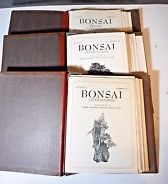
|
BCI Magazine Binders, 1978-1981 shown here in a stock photo.
RJB's from Phoenix Bonsai Society (due to Valley Garden Center on-site space limitations) are actually
1968-1989.
|
A preliminary new web page began to be fleshed out.
In May while writing the bottom of the page apology for certain arbitrary definitions, I realized that I needed to
be more detailed with the individual states and provinces listed for at least some of the countries. I
returned to the back issues and additional pages were made. By early September the first draft of this
section
was ready for publication and announced on a few key web sites (early archive copy linked here). It was soon
after this time that links to that section and the Book of Days were added to our
home page (early archive copy linked
here). Additional forums for bonsai enthusiasts around the world had also been added here.
In March 2008, a former work-colleague of mine in Phoenix, Jim Robinson,
interested me in Facebook. Over these years I've
accumulated quite a number of "friends" from around the world, who nowadays occasionally get to see images of
what I consider to be noticeable and extraordinary examples of bonsai (and members of the related arts) as
shared from the numerous posts I see. With proper cross-referencing and discretion, Facebook is also a
constant source of various research data.
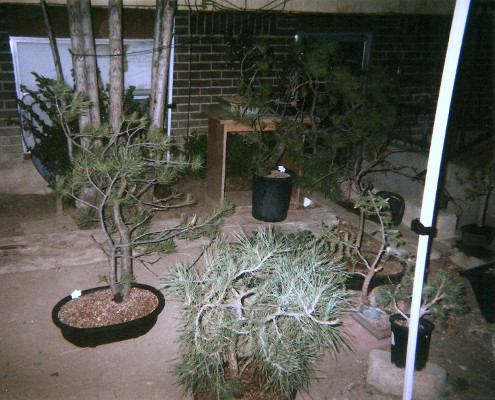
|
Part of RJB Bonsai Collection Spring 2008
The most prominent potted trees in the left two-thirds of this photo are 3 yamadori Ponderosa pines
which I had been very recently gifted by my friend Bill Fox.
|
At the February 2009 meeting, the Pikes Peak Bonsai Society had a class which
was the hands-on making of custom pots with clay that the club had purchased. The pieces were slow-drying,
would be fired in a few weeks, and be ready for taking home in April. This workshop would be repeated the
next two years. Making decent-sized and attractive pots definitely requires a bit of practice, we learned.
At the end of June 2009 I joined the
Ausbonsai Forum, a group of [now] about 8,500 members.
The area of most interest to me, obviously, is "Bonsai in the Media & History of Australian Bonsai." There
I've shared info with my colleague Lindsay Farr and a number of his associates.
During one weekend in July 2009 I put together the initial version of
Earliest
Western Reports of Various Kinds of Trees by reviewing the pre-1800 Books listings and all the historical
articles (early archive copy linked here). Additional articles are now checked for possible updates to the
Western Reports.
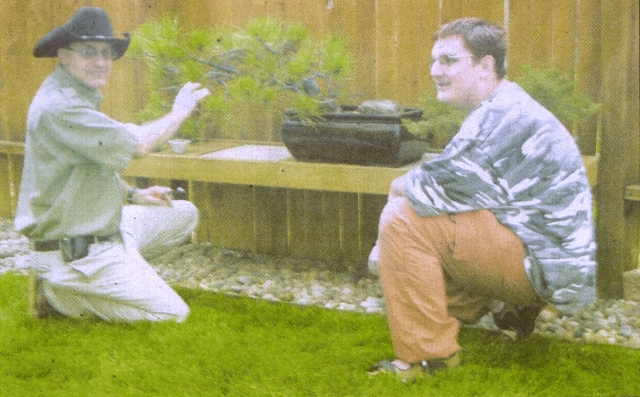
|
|
With son, Kenny Asher, in September 23, 2009 article "The Ancient Art of Bonsai Grows in Fountain" by
Janet Huntington, Fountain Valley News and El Paso County Advertiser and News, Fountain, CO, pp. 1, 66.
Tree is a collected Ponderosa pine owned by my friend Cliff Broyles.
|
The above article was done to get interest in our Pikes Peak Bonsai Society
fall show being held the following weekend. At the show, I was one of the people interviewed for "Bending
the Bonsai Rules" by Maria St. Louis-Sanchez, The Gazette, Colorado Springs, CO, September 28, 2009, pp. A3,
A5. One of our members, Steve Alford, had added a model car tire on a string to one of his bonsai -- and had
more of these for sale. This, of course, represented a tire swing on a full-sized tree. I added my
affirmation to this novel magical miniature landscape addendum.
In mid-November 2009 I came upon an extremely brief Wikipedia article for
Masahiko Kimura. Realizing that
I had a Book of Days listing for him on March 31, I discovered that my info was
barely more fleshed out. After hunting down a number of additional references, I simultaneously published a
longer bio on this outstanding master in both Wikipedia and Book of Days. I've also added substantial history
(since November 20, 2005) to these bonsai-referenced Wikipedia articles, among others: "Bonsai" (History, now the
spun-off article "History of Bonsai");
"Anson Burlingame" (External link);
"Fort Lupton, Colorado" (Notable people);
"Robert Fortune" (External link);
"Gong Zizhen";
"Hòn Non Bô";
"Marco Invernizzi";
"List of bonsai on stamps";
"List of species used in bonsai"
(External link); "John Naka";
"National Bonsai Foundation";
"Noh" (External link);
"Penjing" (History); and
"Wu Yee-sun" (References). (Over the years, some of
this material has also been used in non-English versions of the articles...)
And created two articles, bios on Yuji Yoshimura
and Bill Valavanis.
Plus substantial additions to our Book of Days project. (Also, I've occasionally added to another
Wikipedia article, a sight most days out my [old house] back and now [new house] front windows,"
Pikes Peak.")
On November 12 I gave a slightly more than one hour talk as part of a
three-hour class on video shitakusa or accent plants. The art instructor at Colorado College here
had seen a display the previous year at the New York Botanical Garden which featured traditional accent plants.
After the Pikes Peak Bonsai Society's fall show this past September, the topic came up and he was eventually
referred to me. I was intrigued by the theoretical concept of video accent plants but had no idea how this
would be pulled off. What -- have a little 5" TV screen off to one side? The results were intriguing:
please see the details here as I described them to the Internet Bonsai Club forum,
Part I
and then Part II, which was the talk and
display for a second class the following February. (This is what I consider the best part of my historical
research: seeing others' interpretations of the usual material and meanings.)
Setting up the various obituaries in the Bonsai Book of Days project causes me
to feel another thread of the big tapestry that most others don't/can't experience -- a further sense of connection
with this art/hobby and playing the self-chosen role of both bearer of sad tidings and glad memorializer. Of
course, I read each obit that I publish. But basically I first have to craft each from one to a dozen
different sources -- some postings known to other enthusiasts and some not -- eliminating duplicated info,
following-up by searching for additional details along certain uncovered lines especially with conflicting data,
finding what these individuals did as bonsai enthusiasts and, hopefully, a few other aspects of their lives and
families, and also, less commonly, getting more details from family members through e-mails I initiate or which
come to me by the family's own search inquiries. I am pleased that I did my job properly when I get positive
feedback from friends or families of the departed -- or from living enthusiasts who are similarly listed or want to
be listed in the Book of Days.
March 2010 saw the introduction of Pots and Potters,
a grand listing on that often-untold portion of this. And I significantly added to the number of
Conventions, Symposia and Exhibitions we have listed. A
curriculum vitae (CV) of sorts was first published. Please look at it.
At the Rocky Mountain Bonsai Society show in Denver, CO on June 19, 2010, I
was able to have a conversation with guest artist Kathy Shaner. I specifically asked her for updates about
the Burlingame or Abraham Lincoln Oak that
she and her teacher Yasuo Mitsuya had earlier worked on, which I had recently been researching.
In late July 2010 the Phoenix club added an assistant to the webmaster in the
person of Eric Zimmet. His extensive experience in computers and web design allowed us to modernize some
elements of the web site, especially the home page and Phoenix club section. The on-line home page was made
to reflect ongoing changes to the proposed one so that the roll-out of the revision would not be quite so jarring
to that very small portion of the public who visited that website. A more organized presentation of links
was put together on the home page and on the Magical Miniature Landscapes
page. I was able to split some more of the very long pages, which I had already started to do earlier that
year.
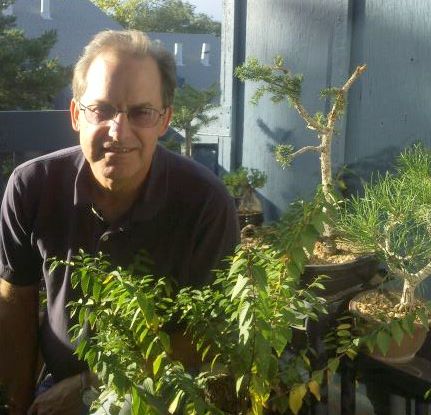
|
Part of RJB Bonsai Collection October 2010
(photo by son Andrew Baran)
|
Since at least December 2010 I've also been a member of the
Bonsai Nut forum, [now] with over 10,000 members.
The year 2010 ended with the introduction of the
How
Many Enthusiasts Are There page (early archive copy linked here). Through its posting on the Internet
Bonsai Club forum, I was then contacted by Oscar Jonker of Belgium of
bonsaiempire.com. From this series of communications (e-mail,
IBC, Facebook) I got some updates to the Enthusiasts page and also the opportunity to create a
detailed history for the English portion of Oscar's
site. That history is a custom five-page version of the 18-page talk I've distilled from the 60+ page
Timeline. The following April I let Oscar publish
The Synergy of Magical Miniature
Landscapes. It had originally been presented by me as a lecture before the Pikes Peak Bonsai Society in
May 2009. The article version was slightly expanded and with more quotations.
The first version of the Lineage of Some of
Our Teachers was presented as a schematic in late January 2011. Some additional info and questions by
my extremely helpful colleague, William N. Valavanis, led me to also make a more detailed
spreadsheet version which continues through the present.
In mid-May I started to gather together what few notes I had regarding the
Imperial
Bonsai Collection, something which had enticed me for some time (early archive copy linked here). As
there was very little "out there," I figured this would be another little thing I could summarize. Starting
with Warren Hill's "Reflections on Japan" (NBF Bulletin, Winter 2000), I added a few other notes and some
Wikipedia links. At the end of May I published my initial work with notice of it to a few people, including
Chris Cochrane. Chris referred me to Yoshihiro Nakamizu in Japan, who he said had, at one point, an
acquaintance who was curator of the Collection. Mr. Nakamizu introduced me to his assistant, Ms. Harumi
Fujino, instead, and Harumi was gracious enough to review my material and send me corrections and comments on it
as she could find time to do so. Meanwhile, Alan Walker was another person to whom I showed my draft and he
volunteered to send me scans of the history pages from the 1976 book The Imperial Bonsai of Japan. I
mentioned that it was a resource I would like to see someday, he happened to have a copy, and he very graciously
scanned the oversize pages and e-mailed them to me on June 8. That weekend I worked in much of the material
and then published a longer page. A copy of this I sent to Harumi about the time I received her first
review. A series of e-mails with her and Mr. Nakamizu let me thank them for their extraordinary efforts and
time -- and satisfied them as to my non-commercial, educational intents. This was an open-ended project --
yes, larger than initially described -- but I was in no hurry. Over the course of the next four weeks, Harumi
sent me sections reviewed. As we discovered, not all of my researches she could readily confirm, and some of
her statistics differed from the ones I had found for historical events. I combined our notes for what I felt
would be the best portrayal of the story. And about the time I received the scans from Alan, Chris sent me
the Googlemap coordinates for the Ōmichi Bonsai Shitate-ba. I zeroed in on the site and copied
the image for the web page. Re-reading the material, adding a few more hyperlinks and Harumi's comments,
massaging the text to get it to flow better, the page slowly developed. (It grew "thick and rich," as I
described it at one point -- I never do "fluff.") On July 12, I announced the now 2-section page to several
bonsai forums and on Facebook. Through the end of the year Harumi sent me additional comments and critiques
until she finished the entire article as it was then.
This is an example of my being amazed at how the initial article and early
versions of it grow organically (Kokufuten is just another example, as well
as Portulacaria, among many others I could list here). When I added the
cropped Google images on the top of the second page of the Imperial Collection article,
I was seeing what I had written about grow in the past. When I added the three bottom pictures on page two,
I saw another dimension: not just a static past thing, but still going on. [These words don't really yet
express my feeling about this/these. I'll revise and improve this description as time goes by. As I
have noted to a few people over the years, this website is the equivalent of my "masterpiece" bonsai, were I a
better horticulturalist.]
In March 2012 I began another project: a
comprehensive
list of all plants used in bonsai and the related arts (early archive copy linked here). I
started with the previously devised
Taxonomic
List for Bonsai in Phoenix (first compiled in July 2005), and then seriously expanded it. (The Phoenix
List itself originated from two surveys I did for the club by the early 1990s concerning which trees were used in
Phoenix and how well they did as bonsai. A third survey by the club was conducted in 2009. The
great-grandfather of the list was actually this first jotting I made from a brief chat with club member Sam Lew:)
Now, going back to the late 1960s, I had tried several times to create a
grand taxonomic listing for all named lifeforms. This was partly due to my owning several of the
Golden Nature Guides. In pre-word-processing days, I
gathered many hand-written notes, eventually segueing to several Access databases with between 7,000 and 8,000 entries.
With the appearance of detailed lists by Phylum, Class, Order, Family, and so forth on the Internet, some of the
steam was taken out of my many-year quest. But the elusive dream remained. So I specialized in a wide-ranging
fashion. (By the early 1990's I'd compiled a text listing of a couple hundred of the most used trees in bonsai
worldwide which I came across in the articles and books.) In September 2012 I debuted my bonsai taxonomic listing
on the Facebook Group of Lindsay Farr's World of Bonsai.
The listing has grown to nearly 1,800 species, and it was split up into the current format after the count
surpassed 1,000. Ideally, I would like to have here over 95% of all the plants used as the primary focus for
bonsai, penjing, hòn non bô, etc. around the world. Examples of the less common specimens as
dwarf potted trees, in theory, could be linked to a picture, but where do you draw the line at a single truly
representative style? -- or what exactly is "less common"? Copyright issues would probably be the biggest
challenge for this universal library of bonsai types -- something I am not yet ready to commit to. Almost
every month I add a species or two to a small spreadsheet I have by plant family, mostly because of trees posted
by my myriad Facebook "friends.". After I've got a handful or more of the binomial names of these new species
they are added to the grand published listing.
A few of the other grand spreadsheets I started to compile over the years were a listing of dinosaur genera, the
characteristics of the brightest stars (something I actually started in early high school), all human-edible
plant/algal/fungal/cyanobacterial foods, and major earthquakes during the past several centuries. Obviously,
nowadays on the worldwide web can be found this kind of information in greater detail, so I don't update my sheets
very much...
June 2012 saw an ABS convention in Denver, perhaps an hour north of me.
Naturally, I went -- with my older son Kenny Asher who accompanied me for a number of years to events
of the Pikes Peak Bonsai Society. (He took most of the people pictures with a new digital camera I had been
gifted a week earlier for Father's Day. If I had known of more of that device's features at the time, I
definitely would have gotten some video footage.) At the convention I finally got to meet my collaborator
William N. Valavanis, who promptly introduced me to Ryan Neil as someone Ryan needed to meet. I
also met Dr. Tom Elias, Dan Robinson, Marc Noelanders, Lindsay and Glenis Bebb, Frank Mihalic,
Kathleen Emerson-Dell, and Iris Cohen. Harold Sasaki -- who I had previously met through the Pikes Peak
Bonsai Society -- was there and we chatted some more about his family. Someone who contacted me a few months
before the convention was Thor Beowulf, an Australian who was working on his bonsai-based PhD thesis. We
made a point to get together in Denver, where Thor interviewed me about the different stages that bonsai education
had passed through during the previous seventy or eighty years. Unfortunately, he wouldn't be able to finish his
thesis before he passed away in early August 2015. His wife and sons planned to eventually have his material
in a memorial research library. (A picture missed being taken at the convention would have been one with
Thor standing next to Kenny demonstrating their coincidental physical resemblance.)
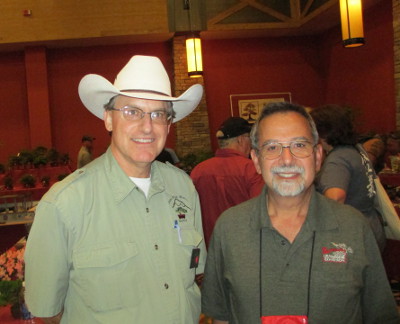
|
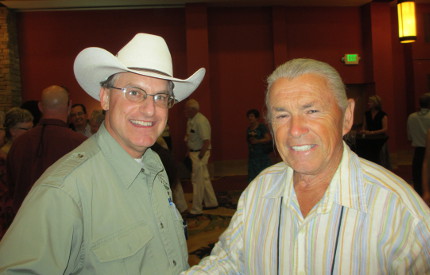
|
|
With Bill Valavanis (all photos by Kenny Asher)
|
With Dan Robinson
|
|
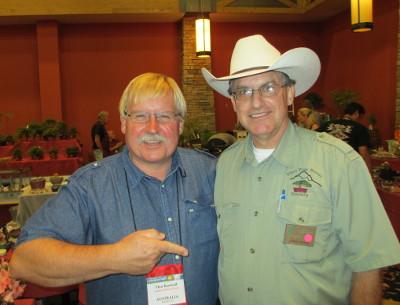
|
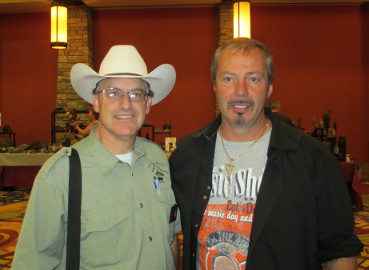
|
|
With Thor Beowulf (Australia)
|
With Marc Noelanders (Belgium)
|
|
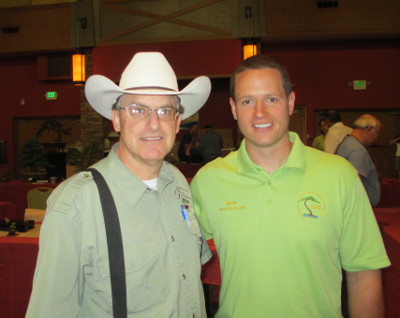
|
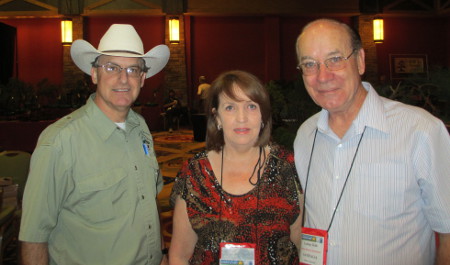
|
|
With Ryan Neil
|
With Glenis and Lindsay Bebb (Australia)
|
|
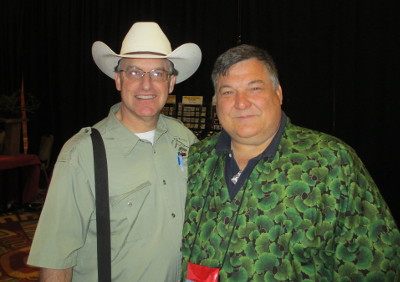
|
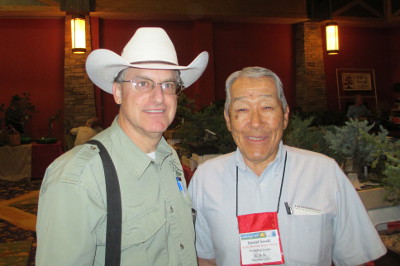
|
|
With Frank Mihalic
|
With Harold Sasaki
|
|
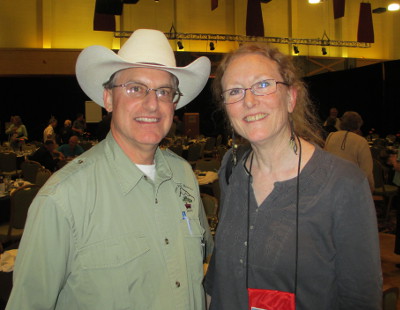
|
|
With Kathleen Emerson-Dell (Natl. Bonsai Museum)
|
Oscar Jonker from bonsaiempire.com approached me via e-mail in December 2012
to collaborate with him on answering the question "How Big is Bonsai" in the world. We discussed some of the
parameters of the project, compiled data -- mostly from the phoenixbonsai.com site -- and he devised the map.
The first edition was
published April 4, 2013 and included some 104 countries and territories. I compiled data for the United
States, D.C., and Puerto Rico, and submitted that to Oscar. He then compiled similar info for the European
nations. The second edition was
published August 7. Material from my 2011 history article for bonsaiempire was then included in their 2014
e-book, The Bonsai Beginners Guide.
On October 1, 2013 I was one of eight persons chosen to comment on
"Why
Bonsai Deadwood Dominate[sic]?" for bursabonsai.com,
an English-language site from Indonesia. I was then asked to write an individual article on
The
History of Kusamono, which was published three weeks later.
Some of the plants I've tried as bonsai so far in Colorado have been
nursery-grown: Amur maple (Acer ginnala), Japanese Maples (Acer palmatum), Norfolk Island pine
(Araucaria heterophylla), Ginseng Ficus (Ficus retusa), Ginkgo (Gingko biloba), Junipers
(Juniperus communis), Dwarf Alberta Spruce (Picea glauca albertiana), Mugo pine (Pinus muga
var. pumillo), Austrian pine (Pinus nigra), Variegated Elephant food (Portulacaria afra
variegata), Purple-leafed sand cherry (Prunus besseyi x cerasifera), Rosemary (Rosmarinus
officinalis), Yew (Taxus sp.), and Chinese elm (Ulmus parvilfolia); yamadori and gifted to me:
Engelman spruces (Picea englemannii), Ponderosa pines (Pinus ponderosa), and Douglas firs
(Pseudotsuga menziesii); yamadori and/or "volunteer" seedlings that I collected: Rocky Mountain maple
(Acer glabrum trisectum), Russian olive (Elaeagnus angustifolia), Junipers (Juniperus sp.),
Aspens (Populus tremuloides), Canadian choke cherry (Prunus virginiana), Wild Gooseberry (Ribes
inerme), Lilacs (Syringa sp.), and Siberian elms (Ulmus pumila); from seed: Red maples (Acer
rubrum). All of these were recorded on a single, long .doc page. Trees that died are moved further
down the page and put in gray type rather than black. Where possible I have photos included.
|
